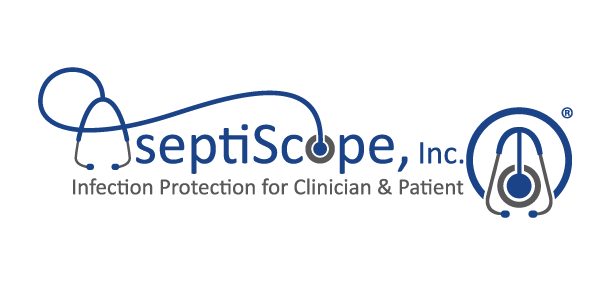February 5, 2020, San Diego, CA. – AseptiScope, Inc. and clinical researchers from the University of California San Diego School of Medicine announce study results that confirm aseptic medical grade barriers, when applied to stethoscopes before clinical examinations, eliminate patient exposure to harmful bacteria, including the superbug MRSA. In the controlled study published today in Mayo Clinic Proceedings, investigators evaluated the presence of harmful bacteria and human contaminants on unprotected stethoscopes compared to stethoscopes that were covered by single-use barriers. When applied to stethoscopes, the barriers prevented the growth of infectious anaerobes, yeasts and antibiotic-resistant bacteria, including vancomycin-resistant Enterococcus faecium, methicillin-resistant Staphylococcus aureus (MRSA), extended spectrum beta-lactamase producing Escherichia coli, and multi-drug resistant Pseudomonas aeruginosa.
According to the U.S. Centers for Disease Control and Prevention (CDC), stethoscopes are known to harbor dangerous pathogens and should be cleaned for at least one minute with an alcohol- or bleach-based disinfectant before and after each patient interaction. However, as evidenced by abundant stethoscope contamination studies, disinfection procedures are infrequently or inadequately performed. The risk of infectious disease transmission is of significant concern to the healthcare system, as nearly 700,000 U.S. cases of hospital acquired infections (HAIs) were reported in 2015. HAIs significantly increase hospital length of stay, cost of care, use of isolation procedures, and high mortality rates.
Today’s study results strongly suggest the applied barriers enable sterile contact with patients and protect from transmission of bacteria, viruses and yeasts that might contaminate stethoscope diaphragms.
“Stethoscope contamination introduces an unnecessary risk of infectious disease transmission,” said Dr. David T. Pride, Associate Professor of Pathology and Medicine and Principle Investigator on the UC San Diego study. “Although we have ongoing work to further address the risk of contamination, this effectiveness study demonstrates a potential patient safety benefit can be achieved using a barrier approach.”
AseptiScope is poised to launch its novel system that addresses stethoscope contamination in early 2020. The wall-mounted, touch-free AseptiScope DiskCover™ System dispenses a disk-shaped barrier in about a second to stethoscopes, creating an aseptic surface during patient examinations. In addition to a clean surface, the barrier is designed to also maintain high quality acoustics clinicians require.
“The study results confirm the DiskCover System elevates stethoscope hygiene and sets a new standard in patient safety,” said Scott Mader, CEO and President of AseptiScope. “The DiskCover System will also save a tremendous amount of time for busy doctors and nurses who struggle with thoroughly cleaning stethoscopes before and after each exam.”
About AseptiScope, Inc.
AseptiScope is a privately funded San Diego, California based, clinical innovation company, formed in early 2016. The organization is founded and led by clinical innovation experts, leading medical researchers and practicing physicians. The AseptiScope mission is to design, develop, manufacture and commercialize novel solutions that ensure “Infection Protection for Clinician & Patient.” The company will introduce the first true and practical solution for the longstanding challenge of stethoscope contamination in early 2020: The AseptiScope DiskCover™ System. Visit www.aseptiscope.com for more information.
AseptiScope is a registered trademark of AseptiScope Inc. DiskCover is a trademark of AseptiScope Inc.
MEDIA CONTACT
Lauren Lehman
858-437-1107

